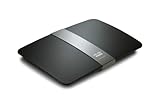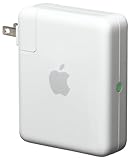
Apple is not always quick to support new technologies, but they threw their weight behind 802.11n Wi-Fi as soon as hardware was available. They upgraded their access points, laptop and desktop computers beginning in 2006, though support importable devices lagged. But the capabilities of 802.11n devices varies widely, and today’s Apple devices are no exception.
802.11n Capability Refresh

As I discussed in detail last week, there are four main technology enhancements to 802.11n: MIMO and multi-streaming, 40 MHz channels, 5 GHz radio spectrum, and various packet enhancements. Each of these is optional for 802.11n devices, and Apple has picked a subset to support.
Basic 802.11n devices operate in the same 2.4 GHz radio channels as earlier Wi-Fi technologies. Many also lack the multiple radios and amplifiers required for multi-stream performance, and Apple only supports 40 MHz channels in the 5 GHz range. This means that simple devices are limited to a data rate of 72.2 Mb per second. These compromises are often made to conserve power or due to physical space constraints, so portable devices like the iPhone lack the performance of full-fledged computers.
Most desktop and laptop implementations of 802.11n include radios capable of either 2.4 GHz or 5 GHz operation, and many offer two or three antennas for MIMO and multi-streaming. From 2006, Apple has offered 802.11 draft-n wireless cards in their laptop and desktop line, and all of these boast dual stream, dual frequency radios. Beginning in 2011, Apple has introduced ultra high-performance Wi-Fi offering three spatial streams and up to 450 Mb per second data rate.
When it comes to access points, Apple has aggressively moved toward 802.11n but lacks many of the features found on competitive products. The Apple AirPort line of Wi-Fi access points currently includes both the AirPort Express, with selectable frequency and dual stream support, as well as the AirPort Extreme, which supports both frequencies concurrently as well as triple stream performance. But Apple does not allow multi-streaming or 40 MHz channels in the 2.4 GHz frequency range on any device in their AirPort line.
Apple 802.11n Wi-Fi Device Capabilities
You might also want to read Which iPad is the Best Choice? and Decision Point: Comparing the 2011 MacBook Pro Models
To try to alleviate the confusion around which devices support what 802.11n features, I created the following table. Generally speaking, any Apple access point, laptop or desktop built since 2006 includes selectable 2.4 or 5 GHz support and at least dual stream capabilities. Every Apple TV also includes 802.11n Wi-Fi right out of the box. On the portable device side, both iPad generations, the iPhone 4, and the latest iPod Touch support 802.11n, though performance is limited.
| Device | Max Data Rate | Antennas | Multi-Stream | 5 GHz |
|---|---|---|---|---|
| 2011 MacBook Pro 2011 iMac |
450 Mb/s | 3 | 3 | selectable |
| 2009-2011 AirPort Extreme 2009-2011 Time Capsule |
450 Mb/s | 3 | 3 | concurrent |
| 2007-2009 AirPort Extreme 2009 Time Capsule |
300 Mb/s | 2 | 2 | concurrent |
| 2008 AirPort Express | 300 Mb/s | 2 | 2 | selectable |
| 2006-2010 MacBook 2006-2010 MacBook Pro 2006-2010 MacBook Air 2006-2010 iMac 2009-2010 Mac Mini |
300 Mb/s | 2-3 | 2 | selectable |
| 2011 iPad 2 2010 Apple TV |
150 Mb/s | 1 | 1 | selectable |
| 2010 iPad 2010 iPhone 4 2010 iPod Touch |
72.2 Mb/s | 1 | 1 | no |
Apple Devices with Limited 802.11n Support

Apple’s portable devices sacrifice performance for efficiency when it comes to Wi-Fi. The iPhone 4, 3rd generation iPod Touch, iPad, and Apple TV each have just one Wi-Fi antenna, so they are limited to single stream performance. The iPhone 4, iPod Touch, and first-generation iPad also lack 5 GHz radio compatibility, though the second-generation iPad and Apple TV do include it. This means that households with these popular devices cannot use 5 GHz-only networks, making the dual-band AirPort Extreme more attractive as a base station than the switchable AirPort Express.
Unsupported Apple Devices
Many readers will find that they own devices that do not support 802.11n at all, forcing them to maintain backward compatibility when deploying new Wi-Fi routers. Some very recent devices, including the iPhone 3G S and previous and the first three generations of iPod Touch, require 802.11g to connect. On the computer side of things, pre-2006 MacBook, MacBook Pro, and iMac computers lack 802.11n compatibility. But the Mac Mini is the real standout: It didn’t include 802.11n until the Core 2 Duo refresh in early 2009.
Stephen’s Stance

It is nice to see Apple out in front with a technology like 802.11n, considering their reluctance to support Blu-Ray and USB 3.0. Although expensive, the AirPort Extreme and 2011 MacBook Pro and iMac sport top-of-the-line specs and high performance Wi-Fi. But the lack of 5 GHz support across the board means many users will stick to the crowded 2.4 GHz spectrum, limiting performance. And I’m sure owners of recent but unsupported devices (the older iPhone, iPod Touch, and Mac Mini) will be disappointed to have to stick to 802.11g.
There is no way anyone is going to get close to 450MBps. Thats a strictly theoretical limit.
I just bought the new Airport Extreme 5th generation. Like many others I am finding it much after with better range than previous models.
Indeed, 450 Mbps is a maximum theoretical data rate for 3×3:3 Wi-Fi with 40 MHz channels, and no one will likely get anywhere near that in real-world throughput. That’s way I was careful to say “data rate” rather than just “speed” in this article!
+1
Where’s the Google Plus button??? AddThis is lagging I guess.
Anyway, thanks, Steve. Great info.
The original iPad DOES support 5Ghz.
NO, IT DOES NOT!
It is only 2.4GHz at a/b/g/n
It does. I am using wireless mode, 5G only, iPad 1G + Airport Extreme 4th G.